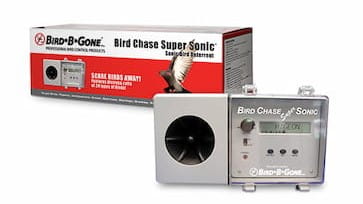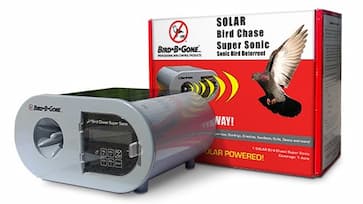Please add the schema tags below
How Sound Bird Deterrents Work To Scare Birds Away
Pest birds can quickly become a costly problem to property owners and managers. The birds will gather in increasingly large flocks to deface and damage property and equipment. Lethal means of bird control—poisons, pellet guns and inhumane traps—are illegal in many areas, since many birds are protected by law. Today’s advanced sound bird deterrents can be highly effective as a humane way to deter pest birds.
Sounds that Birds Hate to Hear
Before we get into what sounds birds hate to hear, it is important to understand the hearing range of birds.
How Do Birds Hear?
Most pest birds such as pigeons, sparrows, geese, crows, seagulls, and woodpeckers, hear within a normal audible hearing range of about 1 to 4 kHz.
Do Birds hear Ultrasonic Sounds? Although birds are known to hear ultrasonic sounds to limits of approximately 20 kHz, the key take away is that these ultrasonic sounds do not affect or deter them in any way.
For this reason, experts recommend avoiding products marketed as "Ultrasonic Bird Deterrents", as these products have little to no effect on scaring pest birds away.
What sounds works to scare birds? Instead of using ultrasonic noises, Sound Bird Deterrents are recommended to focus on “bird distress calls” that mimic each recorded bird species.
What Are Bird Distress Calls & How Do They Scare Birds Away
Birds such as pigeons, seagulls, crows and geese have specific “distress calls.” Birds will emit these sounds only when they are attacked by a predator or when they feel threatened. For this reason, Sound Bird Deterrents intimidate pest birds by broadcasting these prerecorded distress and predator calls to confuse targeted birds.
To people and other animals, these prerecorded bird distress calls resemble normal birdcalls. To you, your neighbor and your pets these recordings sound just like birds.
Bird B Gone’s Bird Chase Super Sonic units have been scientifically designed to fully exploit a bird’s natural alertness and sensitive hearing—hearing that’s similar to humans. Social and aggressive birds that communicate verbally within colonies will often fly towards these distress calls to see if they can mob the predator and come to the aid of their fellow bird.
When the calls temporarily cease and no predator is found, the arriving birds are frightened by the possible danger and disperse.
Different Sounds for Different Birds
The best sound bird deterrents will have the flexibility to broadcast distress and predator calls for as many as 24 different types of birds. These systems allow users to target a specific bird or all birds. Such systems can even be programmed to turn on and off automatically. They will also allow additional speakers to be added to extend the effective deterrent range from one acre to five acres.
Here are some of the most common audio recordings used to deter birds:
- Crow distress calls
- Pigeon repellent sounds
- Sparrow repellent sounds
- Woodpecker warning calls
- Seagull deterrent noises
Electronic Bird Deterrents That Work
Remember, for electronic bird deterrents to be effective they need to play recorded bird distress calls. This means the sound device will have to be able broadcast recorded bird calls loud enough to cover large areas. The following two electronic bird deterrents focus exactly on this.
Birds can get accustomed to sounds, even those they may initially perceive as threatening. Therefore the best sound bird deterrents can be programmed to emit threatening birdcalls for several minutes, stop and then repeat the sequence every 10 minutes. These devices feature a volume control that allows the sound intensity of birdcalls to be adjusted—from 65-105 decibels.
The Bird Chase Super Sonic broadcasts distress calls for up to 24 species of birds. This unit is perfect for covering large open areas such as backyards, gardens, golf courses, ponds and more. The base unit covers up to 1 acre in area and has the option of adding up to 4 additional speakers. Each speaker covers up to one additional acre.
2) Solar Bird Chase Super Sonic
The Solar Bird Chase Super Sonic does almost everything the direct charging bird chase unit can. The solar panel allows you to place this unit in areas away from power sources. Although this feature is a plus when covering remote locations, it does not have the option of adding speakers. When sunlight is no longer detected this unit will power off, requiring the unit to be reprogrammed the following morning.
Choosing the perfect electronic sound bird deterrent boils down to your preferences and where you are looking to install the unit.
Make sure to consider these two questions before making a decision:
- Where do I want to install the unit?
- How large of an area do I need to protect from birds?
How to Increase the Effectiveness of Sound Deterrents
Experts recommend pairing sound deterrents with visual scare bird deterrents. This is the easiest way to increase the effectiveness of a sound bird deterrent.
Read More: 5 Popular Visual Deterrents and How They Work
When birds hear the sound of a predatory bird call and distress call, they will associate the sound with the visual predator decoy. This triggers their instincts to quickly flee the area.
Consult the Experts at Bird B Gone
Not sure what bird deterrents will work best for your bird problem? Ask an Expert at Bird B Gone for advice on what you can do to discourage the pest birds in your area. Bird B Gone has over 90 years of combined experience in the field of bird control.



